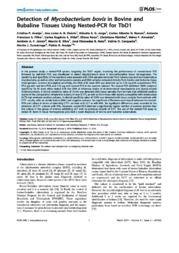Detection of Mycobacterium bovis in Bovine and Bubaline Tissues Using Nested-PCR for TbD1.
Detection of Mycobacterium bovis in Bovine and Bubaline Tissues Using Nested-PCR for TbD1.
Author(s): ARAUJO, C. P.; OSÓRIO, A. L. A. R.; JORGE, K. S. G.; RAMOS, C. A. N.; S. FILHO, A. F.; VIDAL, C. E. S.; ROXO, E.; NISHIBE, c.; ALMEIDA, N. F.; F. JUNIOR, A. A.; SILVA, M. R.; B. NETO, J. D.; CERQUEIRA, V. D.; ZUMÁRRAGA, M.; ARAUJO, F. R.
Summary: In the present study, a nested-PCR system, targeting the TbD1 region, involving the performance of conventional PCR followed by real-time PCR, was developed to detect Mycobacterium bovis in bovine/bubaline tissue homogenates. The sensitivity and specificity of the reactions were assessed with DNA samples extracted from tuberculous and non-tuberculous mycobacteria, as well as other actinomycetales species and DNA samples extracted directly from bovine and bubaline tissue homogenates. In terms of analytical sensitivity, the DNA of M. bovis AN5 was detected up to 1.56 ng with conventional PCR, 97.6 pg with real-time PCR, and 1.53 pg with nested-PCR in the reaction mixture. The nested-PCR exhibited 100% analytical specificity for M. bovis when tested with the DNA of reference strains of environmental mycobacteria and closely-related Actinomycetales. A clinical sensitivity value of 76.0% was detected with tissue samples from animals that exhibited positive results in the comparative intradermal tuberculin test (CITT), as well as from those with lesions compatible with tuberculosis (LCT) that rendered positive cultures. A clinical specificity value of 100% was detected with tissue samples from animals with CITT- results, with no visible lesions (NVL) and negative cultures. No significant differences were found between the nested-PCR and culture in terms of detecting CITT+ animals with LCT or with NVL. No significant differences were recorded in the detection of CITT- animals with NVL. However, nested-PCR detected a significantly higher number of positive animals than the culture in the group of animals exhibiting LCT with no previous records of CITT. The use of the nested-PCR assay to detect M. bovis in tissue homogenates provided a rapid diagnosis of bovine and bubaline tuberculosis.
Publication year: 2014
Types of publication: Journal article
Unit: Embrapa Dairy Cattle
Observation
Some of Embrapa's publications are published as ePub files. To read them, use or download one of the following free software options to your computer or mobile device. Android: Google Play Books; IOS: iBooks; Windows and Linux: Calibre.
Access other publications
Access the Agricultural Research Database (BDPA) to consult Embrapa's full library collection and records.
Visit Embrapa Bookstore to purchase books and other publications sold by Embrapa.

